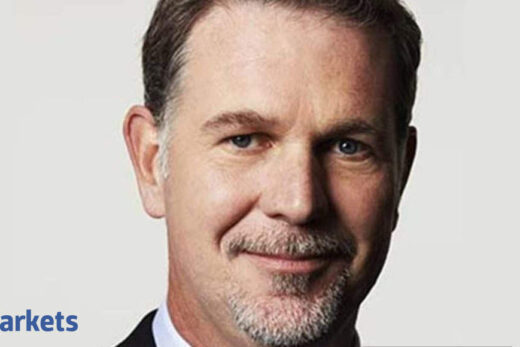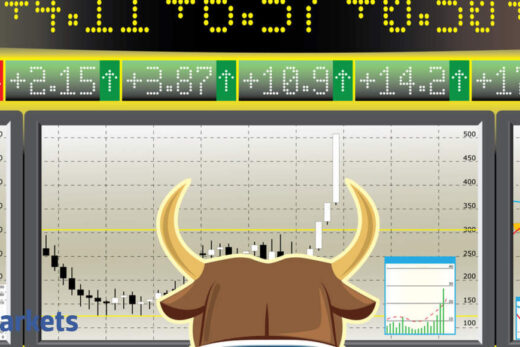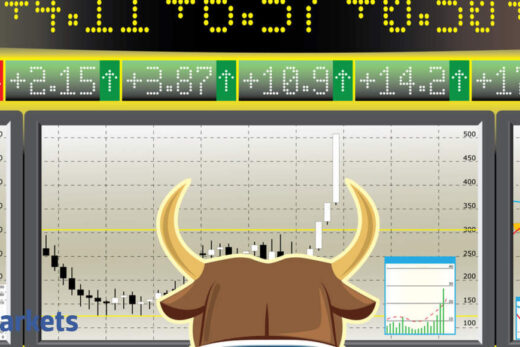With bond yields jumping and inflation expectations surging, this would seem like a strange time for optimism to break out among Wall Street’s equities handicappers.
But that’s exactly what it has done. And the reasons offer a lens into what kept the stock market’s worst three-day decline since October from spinning further out of control this week.
It was hard to notice, but while markets were lurching, stock strategists at securities firms were busy jacking up their earnings estimates for S&P 500 companies. That brought profit projections from these top-down forecasters into alignment with a much bigger set of company analysts, the single-stock researchers who follow individual companies.
While nobody believes the published opinions of strategists are particularly meaningful to the day-to-day motion of share prices, the phenomenon illustrates a dynamic that’s been supporting equities for more than a year. Namely, the slow and almost invisible improvement in corporate profits that’s accompanied growing inflation anxiety and spotty data — and continues to put a floor under selloffs.
 Bloomberg
Bloomberg“It’s going to be challenging to have a deep correction when you have an economy that is very strong and earnings revisions that are still moving up at a brisk pace,” said Keith Lerner, chief market strategist at Truist Advisory Services. “That just provides a cushion for pullbacks, and that’s exactly what we saw this week.”
Dennis Debusschere, head of portfolio strategy at Evercore ISI, was one strategist who boosted his earnings estimates in the face of an equity rout triggered by inflation fears. Citing a faster-than-expected recovery in corporate activity, he raised his 2021 forecast for S&P 500 companies by $6 to $182 a share.
“Inflation is trending higher and supply chain disruptions are a potential threat to profitability, but management sentiment toward margins continued to climb higher,” he wrote in a note to clients earlier this week. “Until that trend reverses, strong topline growth and strong pricing power support” robust earnings, he said.
Slowly but forcefully, Wall Street has come to terms with corporate America’s resilience. Earnings that didn’t fall as much as feared during the initial pandemic lockdowns are now rebounding faster than expected. The net result: A profit recovery that was expected to take years is on track to be done by June, a span of just five quarters.
When this reporting season started five weeks ago, analysts’ 2021 earnings estimate for S&P 500 firms stood at $174 a share. After almost every firm crushed expectations, the expected income has increased 5.7% to $183.90 a share, a pace of upgrading that was the second fastest since Bloomberg began tracking the data in 2012, exceeded only by the 2018 cycle in response to President Donald Trump’s tax cuts.
The trajectory from top-down strategists showed a similar pattern, with projected profits climbing roughly 4% to $185 a share during the past month.
But that’s where the consensus ends. When it comes to where the market goes, the two groups of prognosticators couldn’t be further apart.
 Bloomberg
BloombergWith the S&P 500 nearly doubling in 14 months, strategists tracked by Bloomberg are telling clients to be careful. Even after a string of upgrades, their 2021 price targets average 4,199, within 0.1% from where the index closed Friday. In other words, they see little room for upside.
On the other hand, bottoms-up researchers who focus on single stocks — the buy/hold/sell crowd that weighs in when results are disclosed — are substantially more bullish. Based on aggregate price targets, they say the S&P 500 has another 11% to run from here.
This divergence is the second-widest at this time of year in Bloomberg data going back to 2004.
 Bloomberg
BloombergSo who to believe? Neither side has a monopoly on wisdom — there’s scant record of anyone being consistently right about stocks.
Marc Odo, client portfolio manager at Swan Global Investments, is siding with the strategists, noting that the analysts may be too fixated on the micro side of the businesses and failing to see the big picture.
Some strategists, including Mike Wilson at Morgan Stanley, have warned against extrapolating the latest robust results into coming quarters because supply constraints and labor shortages will likely hurt profits. Others, like Bank of America’s Savita Subramanian pointed to stretched valuations as well as looming policy headwinds, such as tax hikes and central banks rolling back monetary stimulus, as reasons for caution.
“If you get a big cross section of analysts, everyone is going to be bullish on their specific niche and that creates a bullish consensus,” Odo said. “Whereas someone who is approaching it from the top down like the strategists, they’re looking more at the forest and may be able to identify those patches of weakness.”
To Truist’s Lerner, strategists may be forced to catch up should the market continue to march higher.
“The strategists are much slower because they are looking at macro trends,” he said. “They’ll either sit tight with their view and say it’s priced in already, or you’ll see that more with a lag.”



